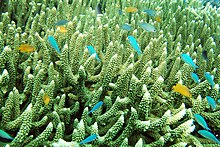History
The name of Raja Ampat comes from local mythology that
tells about a woman who finds seven eggs. Four of the seven eggs hatch and become kingsthat
occupy four of Raja Ampat biggest islands whilst the other three become a ghost,
a woman, and a stone.
History shows that Raja Ampat was once a part of Tidore
Kingdom, an influential kingdom from Maluku. Yet, after the Dutch invaded Maluku, it was shortly
claimed by the Netherlands. The main occupation for people around this area is
fishing since the area is dominated by the sea. They live in a small colony of
tribes that spreads around the area. Although traditional culture still
strongly exists, they are very welcoming to visitors. Their religion is
dominantly Christian.
Geography

Marine biodiversity of Raja Ampat
The oceanic natural resources around Raja Ampat give it
significant potential as a tourist area. Many sources place Raja Ampat as one
of their top ten most popular places for diving whilst it retains the number
one ranking in terms of underwater biodiversity.
According to Conservation International,
marine surveys suggest that the marine life diversity in the Raja Ampat area is
the highest recorded on Earth. Diversity is considerably greater than any other area
sampled in the Coral Triangle composed
of Indonesia, Malaysia, Philippines, Papua New Guinea, Solomon Islands, and
Timor-Leste. The Coral Triangle is the heart of the world's coral reef
biodiversity, making Raja Ampat quite possibly the richest coral reef
ecosystems in the world.
The area's massive coral colonies along with relatively
high sea surface temperatures, also suggest that its reefs may be relatively
resistant to threats like coral bleaching and coral disease, which now
jeopardize the survival of other coral ecosystems around the world. The Raja
Ampat islands are remote and relatively undisturbed by humans.
The high marine diversity in Raja Ampat is strongly
influenced by its position between the Indian and Pacific Oceans, as coral and
fish larvae are more easily shared between the two oceans. Raja Ampat's coral
diversity, resilience, and role as a source for larval dispersal make it a
global priority for marine protection.
1,508 fish species, 537 coral species (a remarkable 96%
of all scleractinia recorded from Indonesia
are likely to occur in these islands and 75% of all species that exist in the
world), and 699 mollusk species, the variety of marine life is staggering. Some
areas boast enormous schools of fish and regular sightings of sharks, such as wobbegongs.
Although accessing the islands is not that difficult, it
takes some time. It takes six hours flight from Jakarta, the capital city of
Indonesia to Sorong. Then, taking a boat to reach the islands is necessary.
Documentary film
The documentary film Edies Paradies 3 (by
Otto C. Honegger) has been broadcast by the biggest Switzerland television broadcaster, Schweizer Fernsehen. The
film tells about Raja Ampat's natural underwater beauty which is likened to
Switzerland's only inhabited area of the region of around 50,000 residents and
is considered like the "Amazon" because of the underwater world located in the
heart of the world's Coral Triangle.
Tidak ada komentar:
Posting Komentar